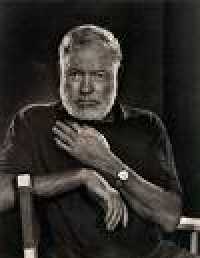Ernest Hemingway was born in 1899 to Dr. Clarence Hemingway and Grace Hall Hemingway. They lived in Oak Park, Illinois, and Ernest actively pursued sports with his father and arts with his mother, but without distinction. In 1917, after graduating from high school, he took a junior position at the Kansas City Star. This paper started Hemingway on a writing career and trained him in his style. The paper gave its reporters a style book which demanded brief, declarative, and direct sentences — Hemingway became the master of this style.
In May of 1918, he volunteered for war duty and served as an ambulance driver on the Italian front. This experience later served as the source material for A Farewell to Arms. He, like his character, was wounded in the legs. However, instead of being returned to the front he was sent home, where he was greeted as a celebrity and passed his months of convalescence at the family cabin in Michigan.
Having recovered, he took a position as companion to a lame boy in Toronto in 1920. There, he again entered the world of writing through the Toronto Star. After marriage to Hadley Richardson, he became a correspondent with the paper. He and his wife left for Paris where Hemingway associated with those writers known as the "Lost Generation" (James Joyce, Ezra Pound, Gertrude Stein, and Ford Madox Ford). His position with the Toronto Star enabled him to begin writing for himself.
His first publishing success was a short story entitled My Old Man in 1923. For the next few years he continued to meet literary figures (F. Scott Fitzgerald among others) and edit a journal with Ford Madox Ford. Then, in 1925, he began The Sun Also Rises and The Torrents of Spring. Both were published the following year. 1926 also saw Hemingway divorce Hadley for his second wife, Pauline Pfeiffer.
In 1927, Hemingway published the short story collection Men without Women and began A Farewell to Arms in 1928. His son, Patrick, was born by cesarean section and this event influenced the writing of Catherine Barkley's fate. With the publication of A Farewell to Arms in 1929, Hemingway found himself flooded with success and began a very mobile life. He frequented Cuba, Florida, and France; he went on several safaris in Africa; he contributed money for ambulance service in the Spanish Civil War and also covered the war for The North American Newspaper Alliance. In 1940 he left Pfeiffer for Martha Gellhorn and published For Whom the Bell Tolls. Hemingway and Gellhorn then went to China. Next, he became a war correspondent with the U.S. Fourth Infantry Division where he met Mary Welsh. In 1945, he married Mary Welsh.
Hemingway continued to publish various works until 1952, when Old Man and the Sea crowned his fantastic career. This story gained him the Pulitzer Prize in 1953. He was awarded the prestigious Nobel Prize for Literature the following year. Unfortunately, by the mid-1950s his adventurous life had taken its toll. Hemingway became depressed and spent time in various hospitals. Finally, he returned from a stay in the Mayo Clinic on June 30, 1961, to his home in Ketchum, Idaho. There, he took a favorite gun and committed suicide on July 2.
Source: http://www.answers.com/topic/a-farewell-to-arms-novel
